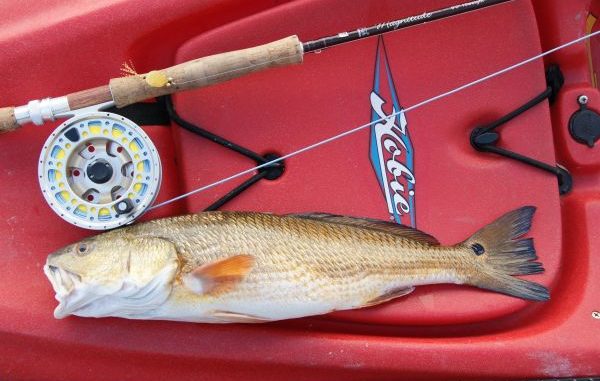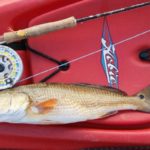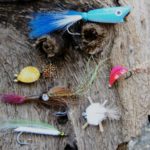
Fly-fishing is great compliment to kayaking
In New Orleans, when two things compliment each other we say they go together “like red beans and rice.”
Just like that popular local staple, you can’t beat the combination of a fly rod and a kayak.
Kayaks have gained great popularity with shallow-water fishing enthusiasts for their ability to ply waters inaccessible to even the most-modern of shallow-water powerboats. A kayak angler can stealthily approach fish that would easily be spooked by most other vessels. This is especially helpful for those wishing to fool such fish with the long rod and a hand-tied concoction.
Fly-fishing from a kayak is admittedly not for the purist. Sitting low to the water in a kayak’s cockpit does not make for long, graceful fly casts. Most kayak anglers won’t be wearing waders or a tactical fly-fishing vest.
However, kayakers using fly-fishing gear and basic casting skills can add a great level of excitement and adventure to their fishing pursuits.
While some kayaks offer the ability to stand and cast, most yak fishermen will have to learn to pitch their fly from the seated position. This will cut down on casting distance and makes for some not-so-pretty, but effective casts.
Any fish you can catch on conventional or spinning gear can be caught on fly equipment. A wide variety of flies are available commercially; however, there is an extra level of satisfaction when catching fish on a bait that you have made yourself. Learning to tie your own flies is not only economical: It also gives you something to do on days when you can’t get out on the water.
Fly-fishermen who are also hunters can gain an extra level of satisfaction by incorporating hair and feathers from game they have taken into their fly patterns.
Fly-fishing from a kayak works well for both fresh and saltwater species. Basic preparations are needed to make the kayak as fly-line friendly as possible, however.
All spare rods and landing nets should be stowed horizontally, or if possible, inside the hull. The definite rule of thumb is that if there is something in your yak that the line can get hooked on, it surely will.
Fly casting will necessarily lead to piles of line in your lap, between your legs and yes, possibly wrapped around your neck. Cover or remove unnecessary cleats, screws or gear that can snag your line. Draping a towel across your lap will cover the snags and allow a place for your line to lie while casting. Being aware of your excess line will minimize the chance of tangles when a fish strikes.
Accuracy in casting is more crucial than distance. Practice landing your fly in the exact spot you choose. Fly fishing in a kayak will put you up close and personal with many wary fish. Proper fly placement could be the difference between spooking a fish and a drag-screaming hook-up.
One disadvantage of casting from the low, seated position of a kayak is that you lose the height advantage that helps you actually see fish in the water. To make up for this, concentrate on your fishing area and learn to read the signs. Experience will teach you to tell fish species by their differing wakes and help determine the best location to cast to a moving fish.
On some days, however, there won’t be much visible activity, even though there are fish around. Although not as exciting, blind casting can also be productive. Hit all of the high-probability areas like points and cuts, and make a cast to any areas that just look “fishy.”
Once hooked, fighting a fish on fly equipment takes more finesse than brute strength.
Take your time to play the fish as long as possible to ensure that it is ready to give up and come more calmly to yak-side. Allowing the fish to pull you in the yak will help tire it much quicker.
Fly rods are usually 9 feet or longer, and can make it difficult to get the fish close enough for capture. A long-handled landing net will make this task easier.
Fly-fishing equipment is generally more expensive than traditional rods and reels. However, reasonably priced equipment is available no matter what species you pursue. From panfish to redfish, there are fly rods and reels specifically designed to handle them all.
The rod is the most-important component of your setup and, therefore, you should get the best one you can afford.
Reels are generally interchangeable between right- and left-hand retrieve. For all but the lightest of panfish, you should choose a reel with an adjustable disk-drag system.
Like most fishing gear, fly lines have become highly technical, with many different styles and features tuned specifically for certain fish species and even different fishing locations. However, you really can’t go wrong in choosing a general-purpose floating line matched to the weight designation of your rod/reel combination.
Lures or “flies,” as they are generically called, range from the tiniest of insect imitations to large baitfish clones. Pick the one that best imitates the prevalent bait or prey in the area you’re fishing. Kayaks generally have less storage space, so pack a handful of your favorite flies and a few pre-tied leaders, and you’re set for the day.
Fly rods will not fit in conventional rod holders found in most fishing kayaks. To protect your rod and make it easier to carry between fishing locations, a specially made fly-rod holder can be purchased at most kayak outfitters.
Fly-fishing will add a new dimension to your kayak fishing and vice versa. The solitude and silence of fly fishing is a perfect compliment to the “stealthiness” of a kayak. Together, they are a very effective and exciting way to fish.




